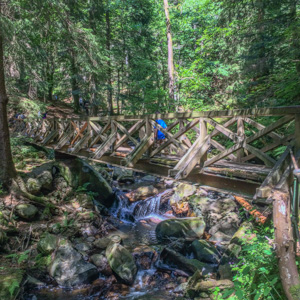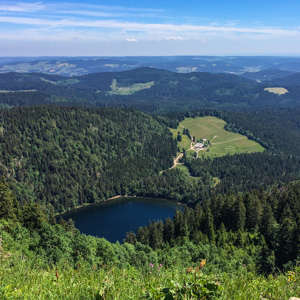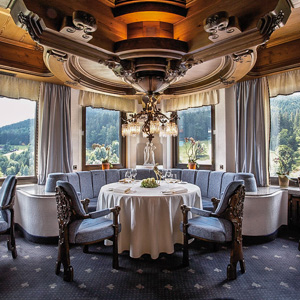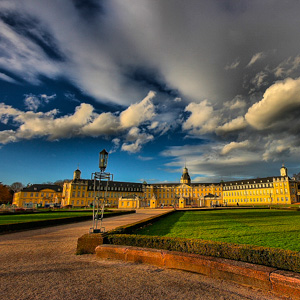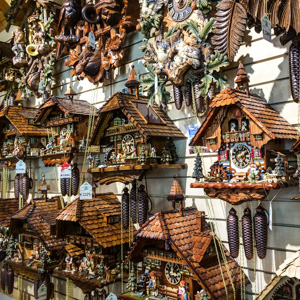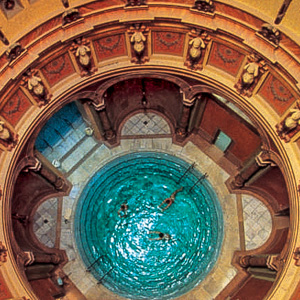The Black Forest
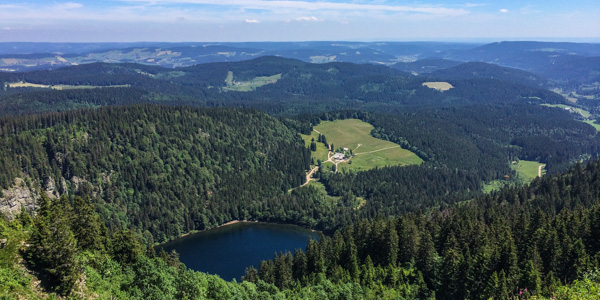
The southern Black Forest from atop the Feldberg, its highest peak.
The Schwarzwald of southwest Germany
Hiking trails and forest vistas, brandy-soaked cakes and genteel spas, mountain lakes and cuckoo clocks—this is the Schwarzwald ("Black Woods") of southern Germany, 4,500 km2 (1,737 mi2) of low mountains where southwest Germany washes up against France.
The region was not really settled until the high Middle Ages, by farmers and woodsmen and smallcrofters who slowly crafted today's Black Forest landscape of stream-fed villages and towns, sheep-shorn grasslands, and tidy mountain farms puzzled between those tall, deep-forested slopes crisscrossed by hiking trials (and, conveniently, the regional train lines to get to you to them).
Oh, and by the way: The true Black Forest ham is the air-dried type—similar to prosciutto—though they also eat that boiled ham edged in black that's usually passed off as "Black Forest Ham" in the States.
And the Black Forest cake? Yeah, it's steeped in kirschwasser—which means "cherry water" but is actually potent cherry schnapps (and they soak cake part, too; not just the cherries).
Most people assume it is called the "Black Forest" for the deep evergreen shades of Norwegian spruce, Douglas fir, and white pine that upholster the region.
Fact is, those conifers—as their foreign names suggest—are all imports, planted in the late 19th century as part of a reforestation effort after eight centuries of human habitation (and one of heavy timber industry) had cleared most of the ancient hardwood and deciduous forests that once blanketed the region.
It was the Romans who first called this region the silva negra, or "Black Woods"—not for its color, but for the sense of forboding they felt upon discovering such a vast track of uninhabited woodlands—no locals to conquer and enslave, nor cleared earth to till. (Some Celtic tribes had settled around the fringes 2,500 years ago, but the heart of the forest remained wild.)
The woods were dark and useless—and possibly evil—so the Romans gave them a suitably spooky name, left one of their patented paved roads through the edge of it, and moved on—though local legend holds that the Titisee is actually named after future Emperor Titus, who supposedly (not really) first discovered this idyllic glacial moraine lake in the heart of the silva negra.
Top Black Forest experiences
Where to stay in the Black Forest
Tips & links
GENERAL
Blackforest-tourism.com, Tourism-bw.com
CITIES
Freiburg.de, Karlsruhe-tourismus.de, Baden-baden.com, Pforzheim.de
PARKLANDS
Northern Black Forest: Schwarzwald-nationalpark.de; Southern Black Forest: Hochschwarzwald.de
Give the Black Forest at least two days so you have plenty of time to take a decent day-hike or two as well as sample the cake and see some of the sights in the cities at its fringe.
- Baden-Württemberg tourist info:
- Tourism-bw.com
- Germany.travel
- Stuttgart-tourist.de
- Blackforest-tourism.com
- Heidelberg-tourismus.de
- Bodensee.eu
- Oberschwaben-tourismus.de
- Konstanz-tourismus.de
- Tourismus.ulm.de
- Baden-baden.com
- Activities & tours:
- Viator.com
- ContextTravel.com
- Intrepidtravel.com
- Gadventures.com
- Infohub.com
- City-Discovery.com
- Localguiding.com
TRANSPORT
- Airfares:
- Momondo.com
- AutoEurope.com
- Vayama.com
- CheapOair.com
- Cheapflights.com
- DoHop.com
- CheapTickets.com
- Priceline.com
- Airports:
- Stuttgart-airport.com, Fly-away.de (Lake Constance); Other airports within 200km: Frankfurt-airport.com, Euroairport.com (Basel), Munich-Airport.com, Zurich-airport.com
- Car/RV rentals:
- Autoeurope.com
- Momondo.com
- RentalCars.com
- CheapOair.com
- AutoSlash.com
- Trains:
- Bahn.de
- Raileurope.com
- Seat61.com
- Apartments & villas:
- Vrbo.com
- Booking.com
- Venere.com
- Rentalo.com
- Homeaway.com
- Belvilla.com
- Interhomeusa.com
- Airbnb.com
- Villasintl.com
- Craigslist.org
- Hostels & campgrounds:
- Hostelworld.com
- Gomio.com
- Hostelbookers.com
- HostelsClub.com
- Hostelz.com
- Booking.com
- Venere.com
- Agriturismo (farm stays):
- Landtourismus.de
- Bauernhofurlaub.de
- Booking.com
Related Articles |
|
This article was by Reid Bramblett and last updated in July 2014.
All information was accurate at the time.
Copyright © 1998–2013 by Reid Bramblett. Author: Reid Bramblett.
-
GENERAL
Blackforest-tourism.com, Tourism-bw.com
CITIES
Freiburg.de, Karlsruhe-tourismus.de, Baden-baden.com, Pforzheim.de
PARKLANDS
Northern Black Forest: Schwarzwald-nationalpark.de; Southern Black Forest: Hochschwarzwald.de
